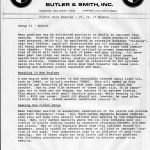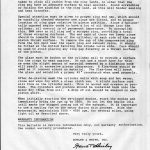This is the service bulletin where B & S suggested washing the cylinders and allowing the walls to rust. This wasn’t from BMW. We had an inside mole at the West Coast B & S facility. He told me that that advice wasn’t factory issued; it was locally generated.
No manufacturer ever recommended allowing rust to get into the oil system. That is crazy. The whole issue of crankcase pressure was resolved by other methods. Read this for an understanding of what dealers had to tolerate when Butler & Smith was the importer.
We did that procedure once, and it was a joke. The very idea of allowing a cylinder to rust up is ludicrous, at best. Did you ever read where any other engine manufacturer recommended using rust for the break-in? No, and you never will. How much rust do you want circulating in your oil and going through the slingers and maybe into the rod bearings?
Soon after that advice, BMW discovered that the oil issues were related to other things. Mostly the rear main seal, breather system, and faulty flywheels. I had informed B & S about the badly machined flywheels and was told that I was wrong. Later a factory bulletin came out about the faulty flywheels.
I personally paid out of my pocket for the cost of having the flywheels correctly machined. I am still waiting for the call of apology and the $35 for each flywheel.
As a BMW dealer, my shop treated many of the bulletins as comic jokes.
When the /6 came out, we had a lot of rear seals that leaked, especially on the 900 cc models, but to some extent also on the 750 ccs. This was blamed on excessive crankcase pressure. They tried a few seals, but none totally solved the leaking.
One day, my genius mechanic, Bryan Hilton, brought me a flywheel to demonstrate something that his sharp eyes picked up. The surface upon which the seal rested had a rough grind and then finished with a fine grind. However, the two grinds didn’t have the same center. On about 1/3 of the circumference, one could barely see the rough grind. The result was that the sealing surface wasn’t round, and part of it was a bit rough. I used a micrometer to measure it; at most, the error in “roundness” was less than one-thousandth of an inch. Not much, but at high rpm, it could be problematic. Also, the rough part was trying to eat away at the seal edge.
We sent it out for a regrind, which cost us $35, and the engine didn’t leak past the seal. After Bryan had proved his theory, I called up Butler & Smith. I explained the finding, action, and result. I was informed that I was wrong, as the seal could easily follow the less-than-round flywheel surface.
A later service bulletin came out with that fix. That expense came out of my pocket, so I don’t recall any warranty recall action. We started having each leaking engine flywheel reground, and they all stopped leaking.
Do you see a business pattern? Do your best to put yourself in our shoes and consider, “What would you do?”
Here is another story.
It was suggested that we locate the ring gaps at the top to keep oil from seeping through them. But that is crazy and stupid. We put them at the top to facilitate installing the cylinder. When you open an engine, you will find that the rings have rotated. Why do you think that 2 cycle engines have pins to locate and hold the rings from rotating? Because they rotate.
Updated 17 July 2022


